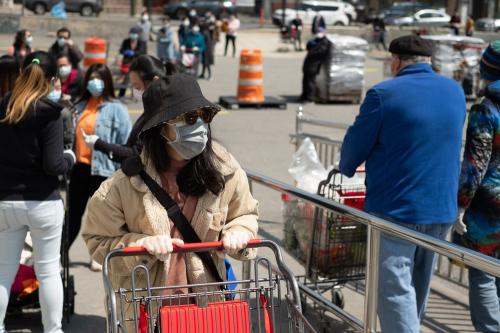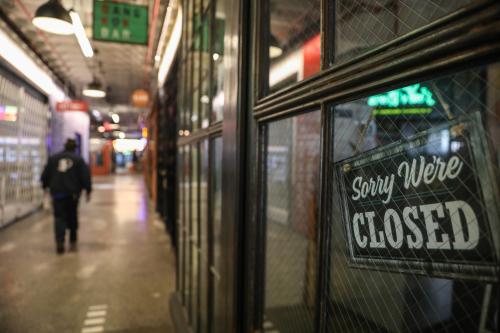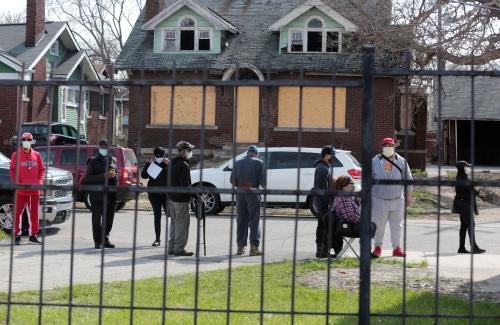The pandemic, which could conceivably have brought the country together, has instead contributed to our growing political divides. Partisan affiliation is often the strongest single predictor of behavior and attitudes about COVID-19, even more powerful than local infection rates or demographic characteristics, such as age and health status, as we show in our new paper, The Real Cost of Political Polarization: Evidence from the COVID-19 Pandemic. Accordingly, a state’s partisan orientation also explains its public health policies, including the timing and duration of stay-at-home orders, bans on social gathering, and mask mandates.
In the paper, we analyze survey responses from just under 50,000 U.S. adults surveyed repeatedly by Gallup from March through August, as well as publicly available policy and political data from a variety of sources.
The implications are unfortunate. Ideally, public health policy would be driven by theory and evidence, not the relative power of partisans. State leaders have missed opportunities to adopt mask ordinances, limit gatherings in the most dangerous indoor spaces, and allow businesses to operate safely. Bad COVID policy, distorted by partisanship, has cost lives and jobs, as our work shows.
Polarization of individual attitudes and behaviors
When the pandemic started, two of the most popular news programs—both on Fox—covered it very differently. Tucker Carlson emphasized the disease’s severity while Sean Hannity downplayed it, according to striking research from Leonardo Bursztyn and his co-authors. In survey data, they find that Hannity’s viewers waited longer before significantly changing their behavior compared to Carlson viewers, who were otherwise demographically similar. More Hannity viewers predicted more infections at the county level. The “Hannity Effect” illustrates a much larger pattern: Access to information is heavily distorted by our media diet, and that has real consequences for attitudes and behavior.
Using Gallup data, we document large and persistent partisan gaps in levels of fear over COVID-19, social distancing, mask wearing, visiting work, and the scope of expected economic and social distribution (Figure 1). We also show that political party support is usually the most important variable in explaining these attitudes and behaviors, dominating county-level infections and other demographic variables.
Politics shapes COVID views

Notably, these gaps in attitudes and behaviors persisted even after the disease burden shifted from being disproportionately high in counties won by Hillary Clinton in 2016 in the spring to counties won by President Trump over the summer. For example, New York City and the surrounding metropolitan area were especially hard-hit in April, with roughly 20% of the population eventually becoming infected, according to CDC estimates of antibody prevalence. Yet, over the summer, deaths per capita were higher in states like Florida and Texas, while plummeting in the Northeast.
The polarization of policies
The individual attitudes of partisans seems to have affected policy in important ways. Throughout the pandemic, people living in states won by Hillary Clinton have been far more likely to live under mask mandates for workers or individuals, stay-at-home-orders, or limitations on social gatherings (Figure 2). These differences can’t be explained by any clear differences in the disease burden or risks across states, since the gaps persist after we controlled for these factors.
Local politics drives COVID response

Stay-at-home-orders and mask-mandates slowed the spread of the virus, significantly curtailing deaths, according to our analysis.
The economic consequences of pandemic politics
The downplaying of COVID, as well as opposition to mask-wearing and other precautions have had real consequences for health and safety. But the polarization of the pandemic has had another unfortunate side effect: Exacerbating economic harm.
We found no evidence that closing all non-essential businesses, for example, reduced the growth in deaths, and yet these policies predict worse economic outcomes, measured in several ways. A growing number of economists and policy experts are starting to question the wisdom of stay-at-home-orders and other extreme measures. In the context of greater access to testing and a better understanding of transmission than we had in March, mask-mandates, social-distancing, and cleaning guidelines seem to work rather well at containing the virus at low levels, until there is a vaccine. This explains how the Northeast has been able to re-open with precautions, without seeing an increase in deaths or an increase in the positive testing rate.
Yet, in Democratic areas, there is still considerable pressure to keep organizations and businesses closed, especially schools, and we’ve even seen recent calls to shut down the entire economy once again. These ideas strike us as unfortunate reactions based on distrust of the President, rather than proposals grounded in evidence. As one of us has noted through Gallup’s partnership with Franklin-Templeton to study COVID, Democrats are more likely than Republicans to overstate the risks of death to young people, whereas Republicans are more likely to mistakenly believe that the flu is more deadly than COVID, as Zacc Ritter of Gallup has documented.
Whatever the public health merits, we find that lockdown policies and business closures do real damage to the economy that goes beyond the actual effects predicted by infections or deaths at the county level. Across a range of economic outcomes—employment, retail visits, work visits, small business revenue, and consumer spending—Republican states have performed better during the pandemic. Currently, the unemployment rate implied by Department of Labor unemployment insurance claims stands at 6.7% in Republicans states, compared to 11.3% in Democratic states (Figure 3).
Red state economies hit less hard by COVID

Mask-mandates seem to lower death rates as effectively as stay-at-home orders, with much less damage to economic activity. With less partisan media and leadership, we believe mask policies and similar interventions would become universally adopted by state and local governments, with high rates of compliance from the public, saving lives and jobs.
The insidious reach of polarization
When Donald Trump debated his Republican primary rivals in 2016, he never mentioned public health. Likewise, these issues were absent from Hillary Clinton’s campaign. It would be fair to say that pandemic preparedness and response was not a hot political topic. To give one example, since President George W. Bush started it, PEPFAR (The President’s Emergency Plan For AIDS Relief) has embodied a major bipartisan commitment to public health, though not entirely without political controversy.
At some point, the pandemic and associated media coverage became yet another deeply divisive political issue – a board for politicians to score points on, rather than a challenge for the nation to rise to. Speeches, tweets, and news coverage became dedicated to giving or taking away points. In an alternative universe, leaders from both parties might have set aside their usual differences, united behind a national strategy, and held each other accountable to implementing it. Tragedy heaped upon tragedy.
The authors did not receive financial support from any firm or person for this article or from any firm or person with a financial or political interest in this article. They are currently not an officer, director, or board member of any organization with an interest in this article.







Commentary
Politics is wrecking America’s pandemic response
September 17, 2020